Online Document
1. Overview
1.1. Function Description
Guandata BI supports integration with Feishu Spreadsheets and Feishu Bitable, enabling users to seamlessly import and synchronize data from Feishu Spreadsheets/Bitables, forming online document datasets. It also supports ETL processing and visualization analysis in Guandata BI, enabling deeper data insights and decision support.
Feishu is an advanced collaboration and management platform under ByteDance, commonly used as a data management tool to store and organize large amounts of business data. In daily enterprise operations, Feishu Spreadsheets are favored for their convenience and powerful collaboration features, becoming the preferred tool for many enterprises to manage and process data. Feishu Bitable is an online database in the form of a spreadsheet, used for data storage, management, analysis, and visualization. The differences between Bitable and Spreadsheet are as follows:
-
Feishu Spreadsheet: Suitable for handling massive data and online data analysis.
-
Feishu Bitable: Supports building business systems such as project management and order management, and constructing automated processes to execute daily standardized information prompts and record work. For example, restaurant chains need to prepare meals daily, and can set up inventory prompt automation to automatically notify relevant personnel about ingredient status.
For details, refer to the official documentation Distinguishing Spreadsheets and Bitables.
1.2. Application Scenarios
After integrating Feishu tables, Guandata BI can fully utilize the existing tools familiar to enterprises, achieving unified data integration and management analysis for various business scenarios at low cost. It helps enterprises make efficient business decisions in sales, finance, and other areas. By reducing repetitive work and quickly connecting Feishu tables, more business data can enter BI and be utilized by business users.
-
Feishu Spreadsheet: Some business personnel use Feishu Spreadsheets as a carrier for daily business collaboration, collaboratively filling in and collecting manual data. These tables often have many fields and participants, and the frequency of modifying cell data is high. For example, sales demand, supply chain inventory, sales targets, etc., are core and frequently used data that also need to be uploaded to BI for analysis and consumption.
-
Feishu Bitable: Some business personnel use Feishu Bitable for data entry and supplementary scenarios, hoping to integrate relevant data into BI for joint analysis with other business data.
1.3. Prerequisites
1. Feishu and BI Platform Authentication Integration
Before integrating Feishu Bitable/Spreadsheet, you must first establish an authentication relationship between Guandata BI and Feishu, and obtain relevant permissions. For details, see Feishu Full Integration Solution sections 3.1 and 3.2.
Note: You need to create a Feishu app and complete the relevant configuration, and enable online document permissions as needed.
2. Assign Permissions to the Feishu App
Go to Feishu's Development Configuration > Permission Management page and enable relevant API permissions for Feishu Docs.
Note: If the permission level in the figure is Requires Review, the published version needs to wait for review. After approval, the permission configuration will take effect.
Feishu Bitable:
At least enable the permissions for "View, Comment, Edit, and Manage Bitables" as shown below. Other Feishu online table permissions can be enabled as needed.
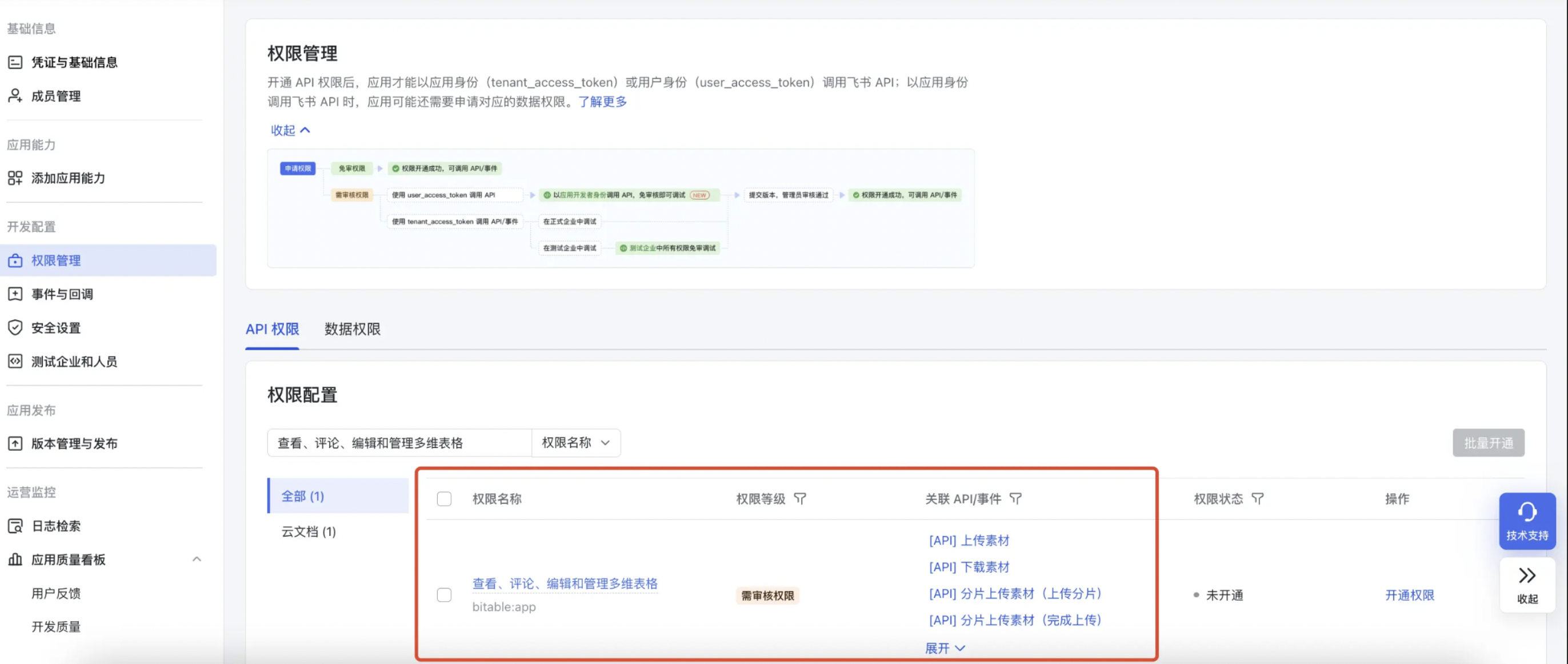
Feishu Spreadsheet:
At least enable the permissions for "View, Comment, and Export Spreadsheets" as shown below. Other Feishu online table permissions can be enabled as needed.

If the document is stored in a knowledge base (the document link is "domain/wiki/..."), you also need to enable wiki permissions. See:
For more details, refer to the Feishu official documentation: Feishu App Integration Instructions.
3. Feishu Table Link Permission Configuration
To integrate Feishu tables into the BI platform, you need to fill in the table link address to access the dataset and complete data reading or writing.
At this stage, you need to pre-configure the sharing permissions for the Feishu table link. There are four sharing methods. Please choose as needed:
-
Organization members with the link can read (recommended, BI will perform organization permission verification);
-
Organization members with the link can edit (recommended, BI will perform organization permission verification);
-
Anyone on the internet with the link can read (publicly visible, may have data leakage compliance risks, please choose carefully);
-
Anyone on the internet with the link can edit (publicly visible, may have data leakage and tampering compliance risks, please choose carefully).
Note: At least assign the "Organization members with the link can read" permission to the table.
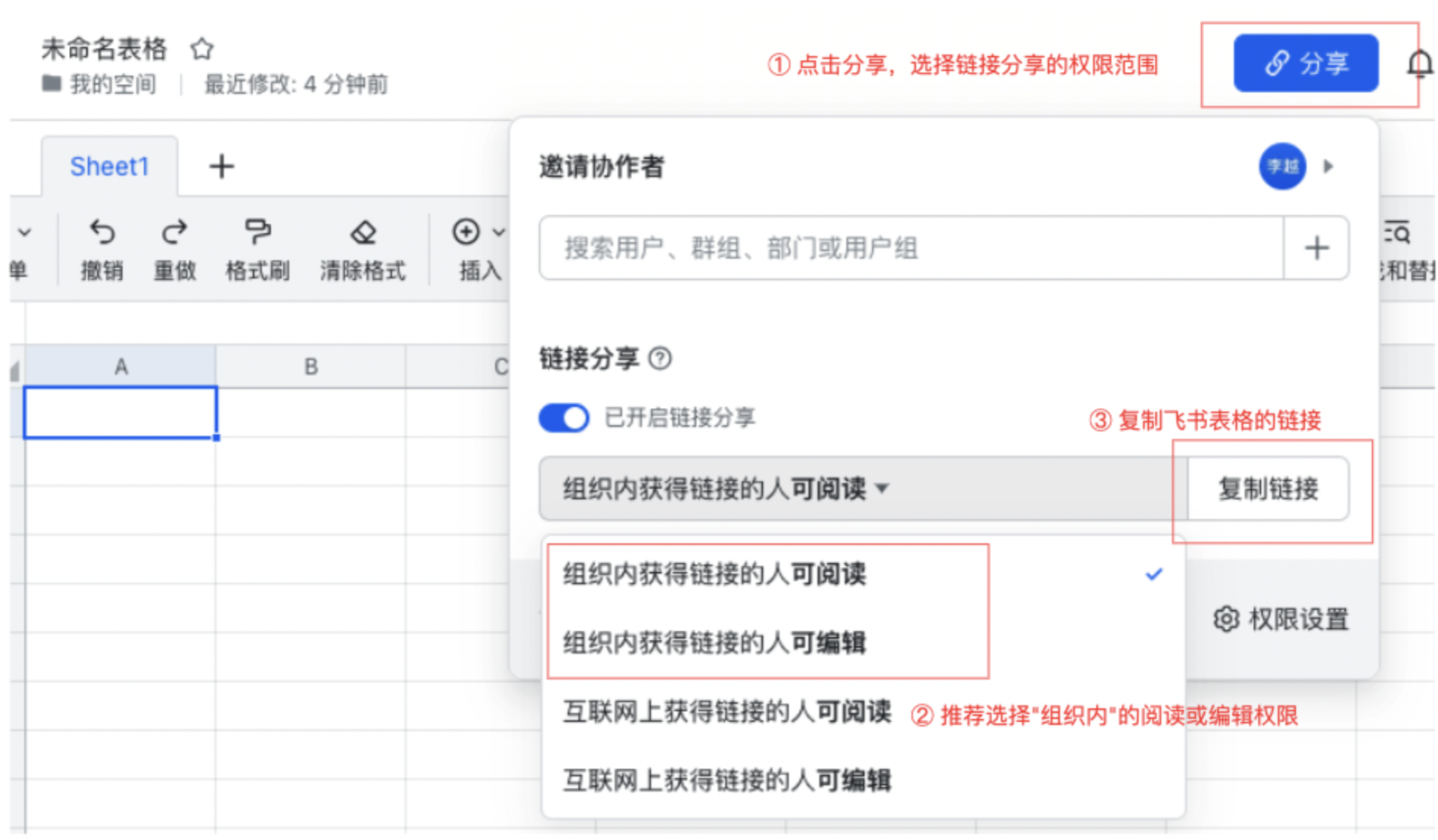
4. Get Table Link
You can copy the Feishu table link in these three places.
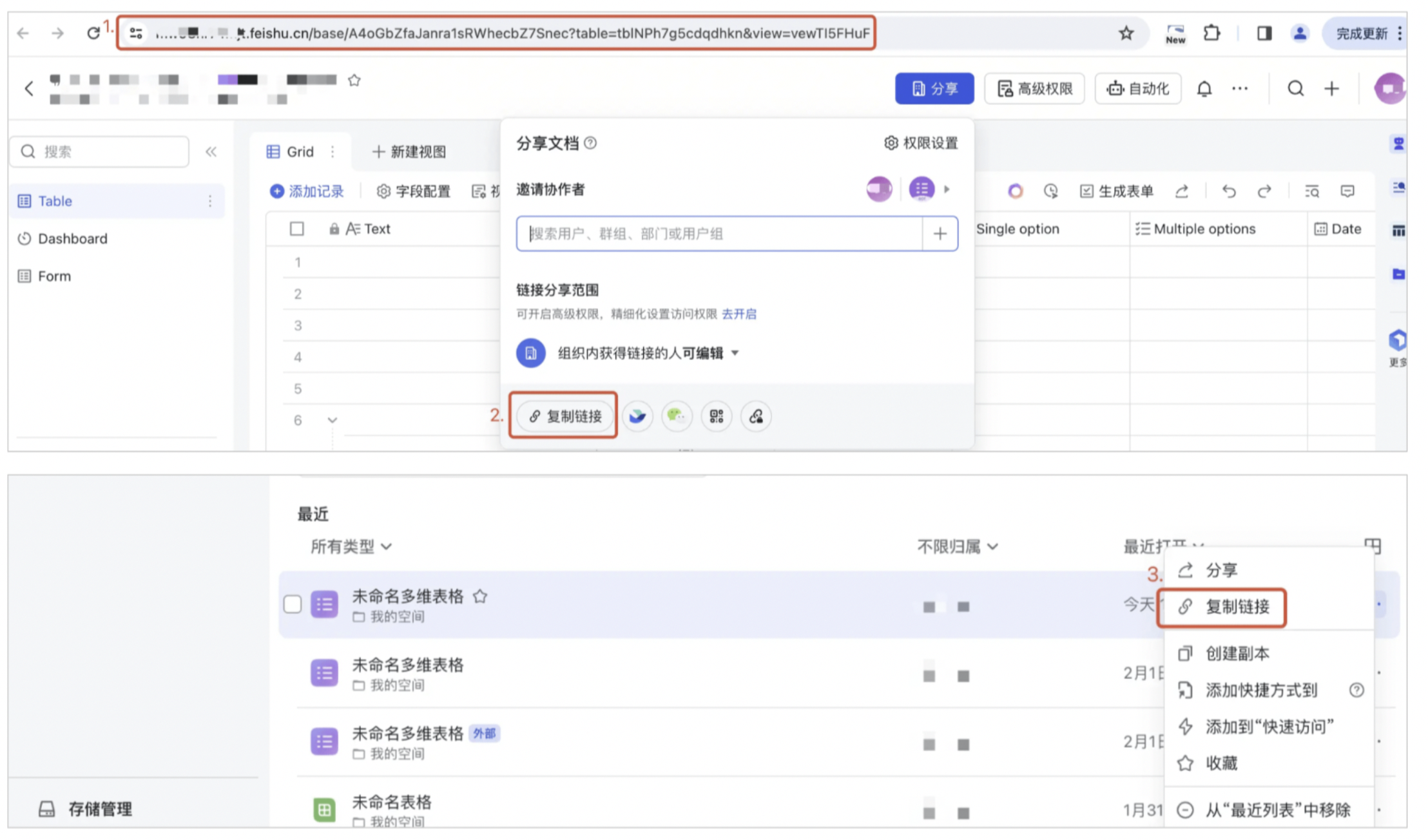
2. User Guide
The configuration process for integrating Feishu Spreadsheets and Bitables is basically the same. You can follow the instructions below to complete the integration.
Operation Steps
-
Enter the "Data Preparation" page and click the "Dataset" module in the left navigation;
-
Click the "New Dataset" button, select File > Online Document;
-
Select "Feishu Spreadsheet/Bitable" and configure the relevant items as needed;
-
After confirming the data table information is correct, click Confirm New to complete the integration.
2.1. Select Connector
Entry: Data Preparation > Dataset > New Dataset > Online Document > Feishu Spreadsheet/Bitable.
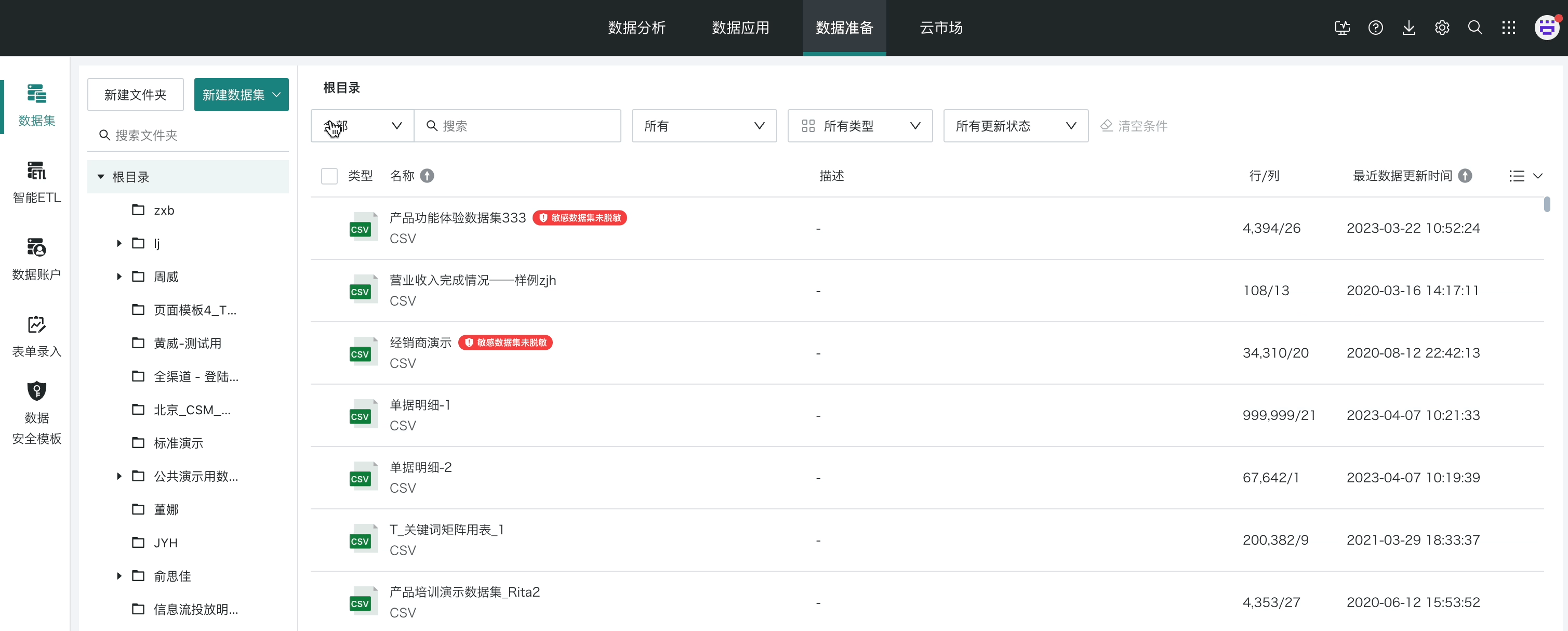
2.2. Select Data Table
Fill in Table Address
Fill in the table link (see above for how to get the link) and click "Get Table".
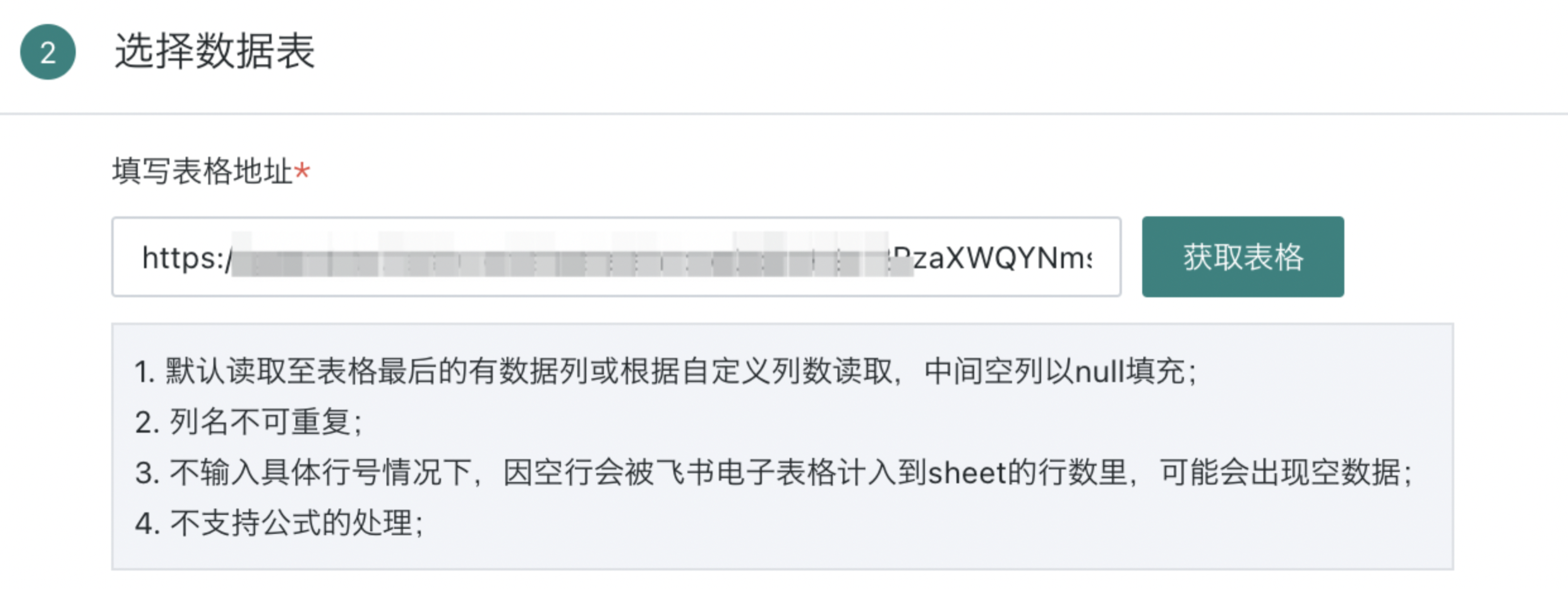
After entering the table link and clicking "Get Table", you may encounter the following error prompts:
| Error Prompt | Handling Suggestions |
| Failed to get, invalid address | Check if the Feishu table is in the same organization as the app |
| Failed to get, invalid address: Feishu API request failed | Check if the Feishu table has enabled sharing link. If the data is too large, the server may time out, or the last modification has not been processed. Retry as needed. If BI does not catch the error, you can usually find the reason in the Feishu official error documentation; |
| Failed to get, invalid address: No permission to get worksheet info, please enable the "Get Worksheet" API permission | Check if the Feishu Open Platform app has the correct Docs permissions; check if the new Bitable has added the corresponding app; |
| Failed to get, invalid address: Feishu not enabled | Check if Feishu is enabled in Guandata BI > System Integration |
| Failed to get, invalid address: Some Feishu authorization configuration items are missing | Check if the Feishu App ID and App Secret in Guandata BI - System Integration are correct, and test connectivity |
| Please provide a valid Feishu Bitable link | Check if the provided link is correct |
| Please check the table link permission configuration | The sharing scope of Spreadsheet/Bitable links needs to be adjusted |
Related Links:
Feishu Open Platform: https://open.feishu.cn/app/
Feishu Table: https://login.feishu.cn/accounts/page/
Feishu App Integration Instructions: Feishu App Integration
Confirm Table Information - Spreadsheet
For Feishu Spreadsheets, after getting the table, you need to set the sheet(s) to be integrated and the target row and column range.
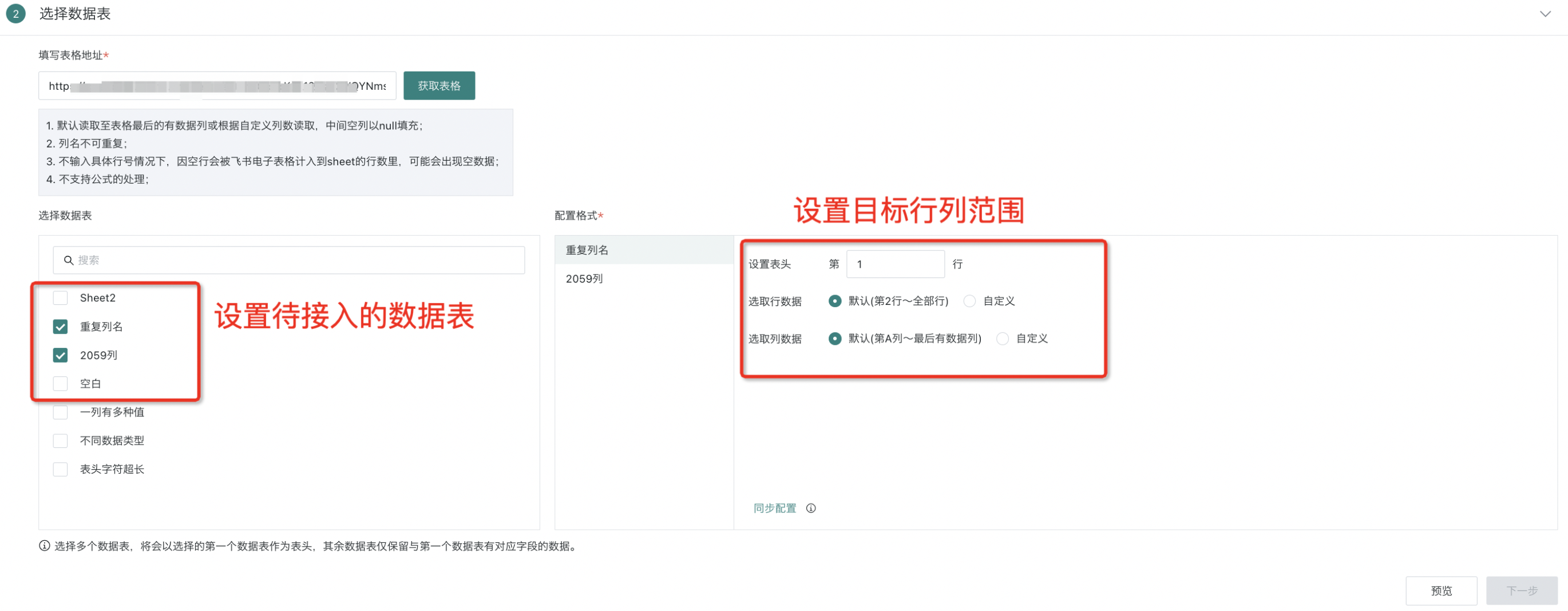
If you need to configure multiple tables with the same configuration requirements, it is recommended to configure one table in detail first. Then, use the "Sync Configuration" function to quickly apply the configured data range and parameters to other selected tables, improving efficiency and accuracy.
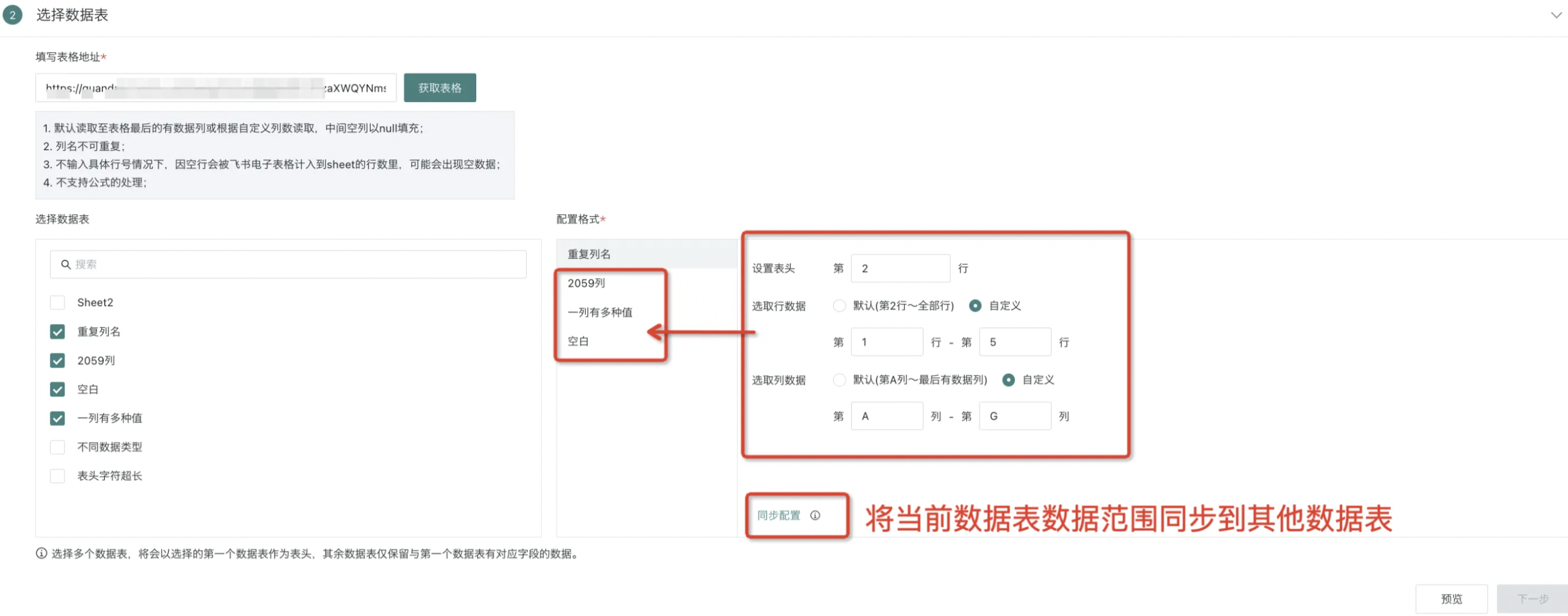
Note:
1. The data reading range of the Feishu table dataset cannot exceed the configured row and column range (when the configuration is default, it will read to the last column with data in the current sheet, and empty columns in the middle will be marked as Null);
2. Column names cannot be duplicated;
3. It is recommended to enter the row data range, otherwise empty data may appear (Feishu will count empty rows in the spreadsheet, and the BI platform will think the row exists and read the data, but the actual row data is empty);
4. Data generated by formulas will only retain the current value when integrated into the BI platform, and formulas are not supported;
5. When selecting multiple sheet tables, the Feishu table dataset will use the first sheet as the header by default, and the other sheets will only retain data for fields that exist in the first sheet.
Confirm Table Information - Bitable
For Feishu Bitable, after getting the table, the first step is to select the required data tables (multiple tables supported), and then configure the format, specifying the row/column range. Column data corresponds to field names, and data rows define the data range.
After completing the above configuration, click the "Preview" button to check the configuration result and proceed to the next step.
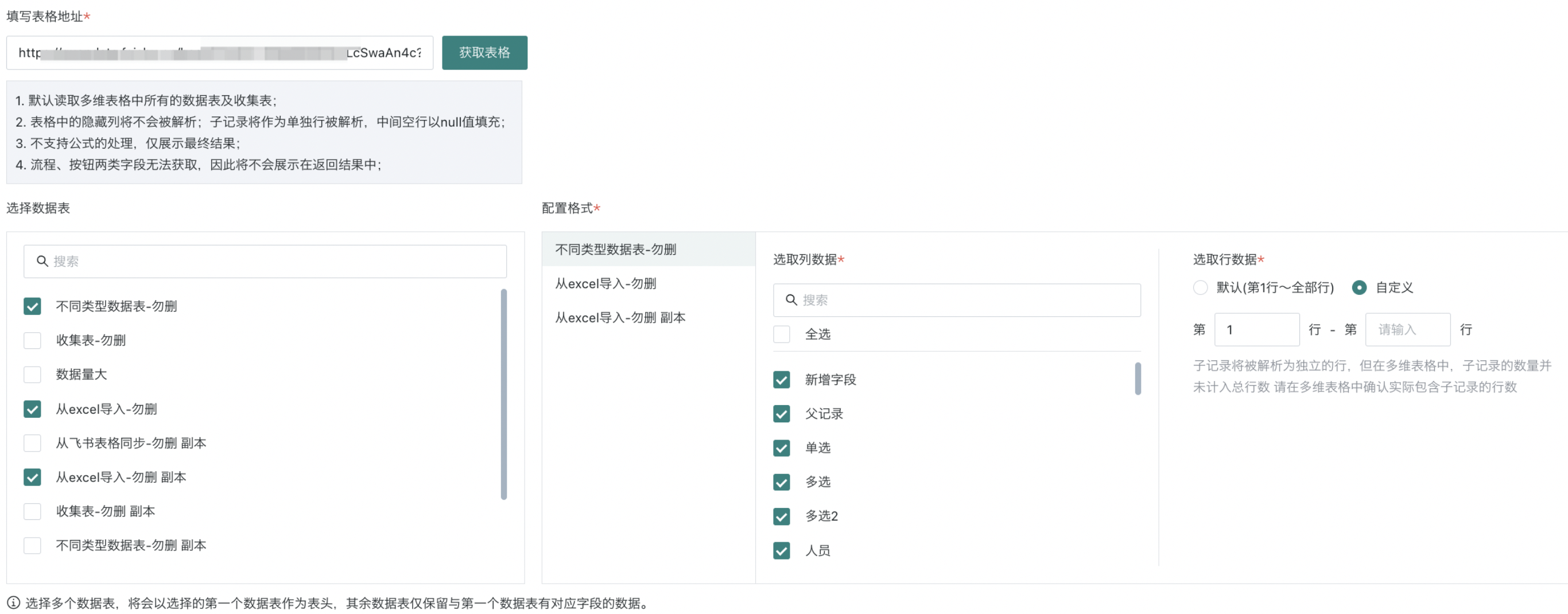
Note:
1. The data reading range of the Feishu table dataset cannot exceed the configured row and column range (when the configuration is default, it will read to the last column with data in the current sheet, and empty columns in the middle will be marked as Null);
2. Column names cannot be duplicated;
3. It is recommended to enter the row data range, otherwise empty data may appear (Feishu will count empty rows in the spreadsheet, and the BI platform will think the row exists and read the data, but the actual row data is empty);
4. Data generated by formulas will only retain the current value when integrated into the BI platform, and formulas are not supported;
5. When selecting multiple sheet tables, the Feishu table dataset will use the first sheet as the header by default, and the other sheets will only retain data for fields that exist in the first sheet.
2.3. Set Update Method
The update method for Feishu Spreadsheet/Bitable data is extraction.
Schedule Status: When enabled, the dataset will be automatically updated according to the data update cycle configuration. When disabled, the system will stop automatic updates. Manual and URL triggers are not affected by the schedule status.
Data Update Cycle: Configure the update task to be triggered daily, weekly, or monthly, accurate to the minute.
Note: A single dataset cannot be updated more than 4 times a day.
Task Priority: You can set the priority of the dataset extraction task to ensure that high-priority business tasks are executed first when scheduled at the same time. There are five levels: Highest, High, Medium, Low, and Lowest. The default is Medium. When a dataset update task is triggered, it will be inserted into the task queue according to the current priority.

2.4. Confirm Data Table Information
Customize the name of the Feishu Spreadsheet/Bitable dataset and save it to the specified path to complete the creation of the extraction-type Feishu table dataset.

